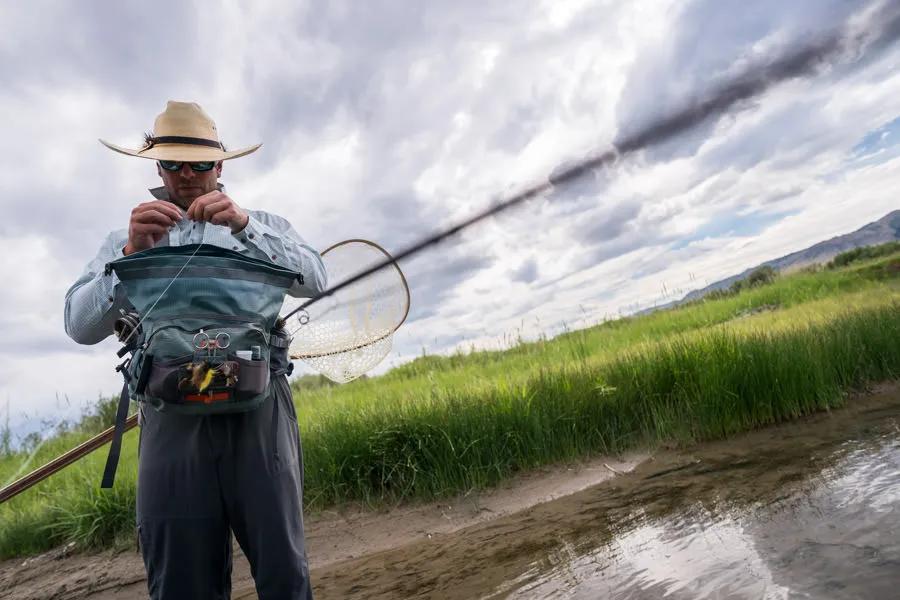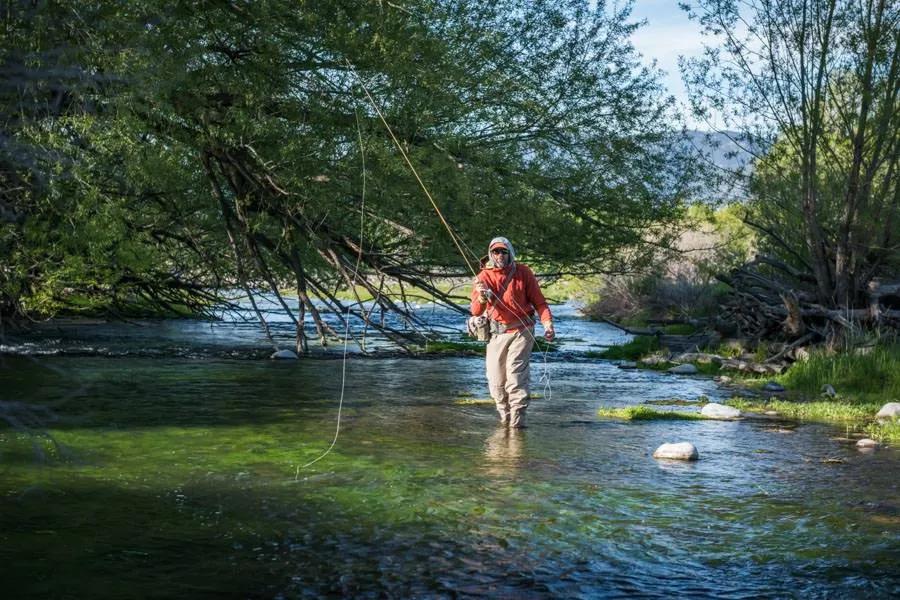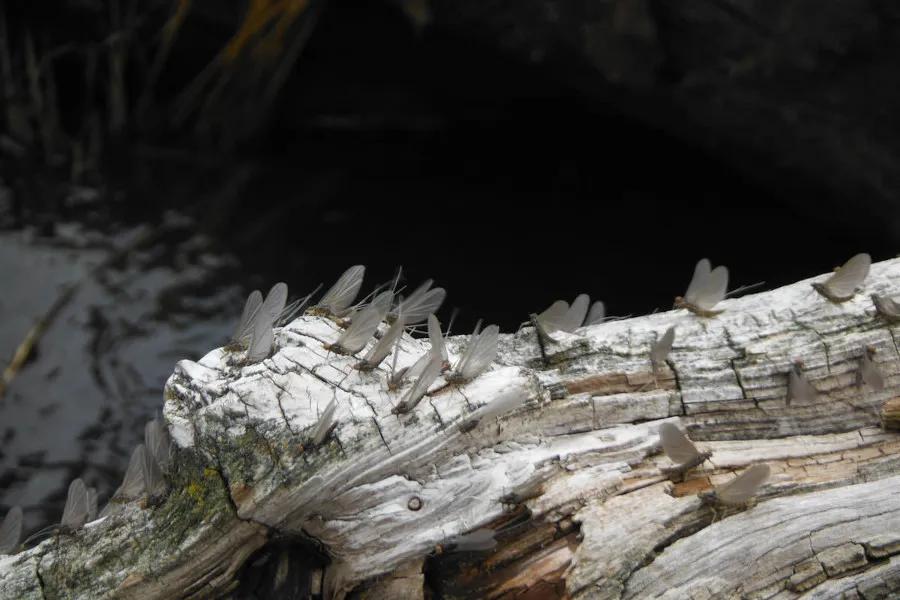
The spring creeks and tailwater rivers of Montana serve up just the right amount of challenge and provide clear and consistent water when other rivers are in runoff or are too cold or too warm to fish. The most famous and the most fishy spring creeks are DePuy’s and Armstrong’s. These two are located a half-hour from Bozeman. If you enjoy larger rivers that have the consistency of a spring creek, consider the Bighorn River in the east, the Missouri River near Helena and Great Falls, or the Beaverhead and Madison Rivers near Bozeman and Ennis.
Most spring creeks are born from water emerging directly from the ground. Spring creeks have clear and consistent flow, which leads to ideal conditions to produce plentiful aquatic insects. Trout become used to this stability and the resulting abundant food. Because of the stable environment trout can become selective. Similar to a spring creek, a tailwater river has flows regulated by a dam, the consistency of streamflow creates an environment similar to a spring creek. Tailwaters often have abundant insect life which can also correlate into abundant populations of trout.

Tweak Your Attitude and Your Expectations
Because many spring creeks are crystal clear and are home to selective trout, your approach to the process is more important than focusing on the result. When fishing a spring creek, satisfaction should be based on quality of experience over the quantity of fish caught. Fishing a tailwater river like the Missouri or Madison can sometimes be the converse of angling on a spring creek–-because insect life is plentiful and trout are numerous, there are times when fishing prolific tailwaters can seem more a function of success than trial-and-error. These times often coincide with thick hatches of the many mayfly and caddis species found in tailwaters.

Rods, Reels, Tackle, and Tippet are Often Lighter and More Sensitive
Most angling situations on spring creeks require lighter rods and more supple fly lines when compared to larger rivers or lakes. A three or four weight rod will present smaller flies smoother and more accurately than a five or six weight. Additionally, the lighter rods have a softer tip that is more forgiving with the lighter tippets often used. Choose leaders that are longer and softer and no less than 12 feet long. Tippet sections tend to be longer, but smaller in diameter—5X is heavy for most spring creeks, so choose 6X. If you use weighted nymphs while sight fishing, be prepared to use micro-sized split shot to obtain the ideal drift. Rod, reel, and tackle selection for fishing tailwater rivers can generally mirror spring creeks, however heavier and longer rods often need to be used.
When dry fly fishing on a Montana tailwater a lot of experienced anglers will opt for a 9-foot 5 weight. For fishing tandem nymph rigs or streamer fishing on a tailwater river, the Montana fly fishing guides who fish these tailwaters often will opt for stiffer 6-weight rods that can more easily turn over heavy streamers or clunky nymph rigs. Leader length and tippet sizes can be consistent with spring creek fishing, with similar exceptions for fishing streamers and tandem nymph rigs. When fishing streamers on tailwaters, go with a short leader–no more than 6 feet. When fishing tandem nymph rigs, length varies depending on the desired depth you want to fish the nymphs. In general, 1.5 to 2 times the depth of the water is a good judge for choosing the appropriate length of your leader.

Embrace Patience and Problem Solving
Because a spring creek or tailwater is filled with abundant insect life, trout inhabiting these waters have plenty of available food. Their need to feed is based solely on the abundance--or lack of–hatching insects. If a heavy hatch is occurring, spring creek and tailwater trout will feed heavily. If a hatch isn’t occurring, then they may feed with little enthusiasm and be difficult to fool. On spring creeks, especially on the Paradise Valley Spring Creeks, it is a good idea to watch the feeding behavior of trout. Are they eating insects below the surface, on the surface, or near the bottom? These questions can aid in appropriate fly selection and tackle adjustments. Acute adjustments are often crucial—changing fly size from 20 to 22 could be the difference between catching a fish or just observing it. Using a dry fly powder instead of a dry fly gel may allow your emerger pattern to float more naturally, enticing a strike versus a refusal. If fishing a tailwater river like the Missouri, more aggressive adjustments might need to be made; such as adding more split shot to the leader, using a larger or smaller strike indicator.

It’s a Bug’s Life on a Spring Creek
Because spring creeks and tailwater rivers often have consistent flows that are beneficial to producing prolific and high-quality insect life, trout on these waters have plenty of options for food. Understanding some advanced knowledge of trout entomology is important. Learn the life cycle of midges, mayflies, and caddis. Know the difference between an emerger, an adult, and a spinner and be able to recognize them on the water. Study riseforms as trout breach the surface. This will help you determine what stage of an insect’s life the trout are feeding on. If you see a nose or mouth, they are most likely eating adults. If you see a back and a tail fin, they are probably eating emergers. Splashy rises mostly mean they are eating emerging or adult caddis. Nervous water but no breach could mean they are keying into active nymphs or submerged emergers. Observe, observe, observe before choosing a fly or making a cast. For example, if you observe splashy rises and even see some fish jumping out of the water, the trout are most likely feeding on emerging caddis.

Learn Some Fundamental Skills to Obtain Better Drifts
Presenting your fly so a fish thinks it’s a natural offering is paramount. Mastering a drag-free drift is a key component of proper presentation. Learning a reach cast, stack cast, or pile cast is a must. Practice adding slack line during a mend to allow your fly to float longer, and more naturally, throughout its drift. A reach cast allows you to mend the fly line before it lands on the surface of the water which means your mend is already working for you before the fly is. The best way to accomplish a reach cast is after you stop the rod on your forward cast, create an extended follow-through by allowing your arm to cross your body. This puts a mend in the line before it even lands on the water. The trickiest adjustment to a reach cast is when the cast is to not land across your body, but it is to land on the other side of your body. When this occurs, the follow through isn't extended, but the rod is pulled backwards. These refined skills are not difficult to master, but they do require practice and patience.

The Sun is Your Friend...and Your Enemy
When fishing a spring creek in Montana, understanding how the sun can help or hurt you is crucial. On a spring creek or if fishing a shallow flat or run on a tailwater, the sun can help you see fish. But, since trout in Montana are always aware of overhead predators like raptors, herons, or even mammals, they are very wary of shadows. On a bright sunny day always be aware of your shadow and where it may be landing. It is also important to be aware of the shadow caused by a casting fly line. That may seem insignificant, but a trout's vision is tailor-made to detect subtle changes overhead, so even the small shadow of a fly line can create enough of a shadow to spoke a trout. When searching for fish it is vital to have quality polarized sunglasses and a wide brimmed hat. A subtle trick if you are having a hard time seeing a fish or if you need to see through some glare is to adjust your body position or tilt your head because even just a subtle movement can make a big difference when looking into clear water.
The spring creek fisheries near Bozeman, Montana include some of the world’s most famous waters. Add to mix the tailwater rivers of the Missouri, Beaverhead, and Bighorn Rivers, anglers looking for challenges–but also waters with enough fish for rewards–can find both in Montana. With such amazing fisheries as the Madison, Yellowstone, Boulder, Missouri, Jefferson, Ruby, Gallatin, East Gallatin, Spring Creeks, small streams, Private ranches and large lakes with a short drive away it is no wonder that Bozeman fly fishing attracts fisherman from around the world.
